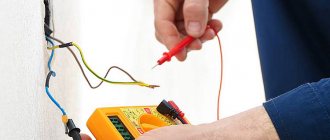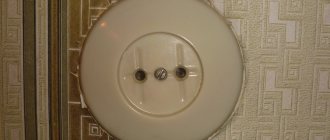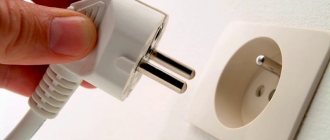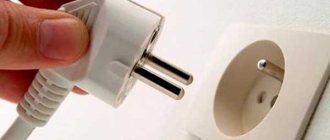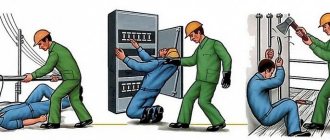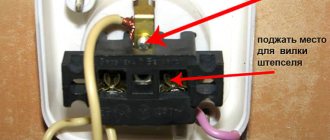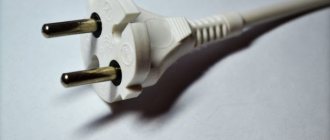It is impossible to completely eliminate the possibility of an electrical fire in an apartment, so you need to know what to do if an outlet is on fire and how to prevent further spread of the fire. By following just a few rules, you can prevent property damage and avoid tragedy. Children should also be taught safety rules and specific actions in the event of a fire in electrical installations, especially those who are left alone in the house for a long time.
What to do if the outlet smells?
This requires:
- De-energize the room, house, apartment. You need to turn off the machine (move the lever to the “OFF” position), or if the device is an old model, then unscrew the plugs.
- Carefully unplug all electrical appliances.
- Call a technician to identify and fix the problem.
21 Dec
2022 Interesting materials:
How to enable edit mode? How to turn on Samsung a50 without the power button? How to enable synchronization on your computer? How to enable IMAP SMTP service? How to enable emoticons on Twitch? How to enable the creation of a restore point? How to enable subtitles in Windows Player? How to turn on t9 on Honor? How to enable an access point on Unlim? How to include an equation in Word?
The main causes of socket outlet fires
Why do sockets in an apartment often burn out and how to prevent a malfunction? There are many reasons for an electrical installation fire, the most probable include:
- Network overload. The home outlet is rated at 220 W. Conventional household appliances cannot reset the electrical wiring, but if you connect several devices to one outlet at once through a tee, then trouble is unlikely to be avoided. This problem especially often arises if at the same time one outlet is used to power a heater, oven, coffee machine, that is, powerful equipment. It is easy to eliminate this cause of fire - you need to plug in one, maximum 2 household electrical appliances into one outlet;
- Poor contact with wiring. Insufficient contact between terminals and exposed wires occurs most often due to metal oxidation. Regular maintenance of the device and timely replacement of an outdated socket with a new one helps to avoid sparks, overheating and fire;
- Plug mismatch. Overheating of the outlet assembly is often associated with a poor quality plug or with the fact that its contacts are gradually weakening. When purchasing equipment, you need to look at what current it is designed for. The contact elements of the plug must be periodically tightened;
- Outlet mismatch. Old electrical sockets are not suitable for connecting electrical appliances with electrodes of increased thickness. Yes, plugs can be inserted into them, but over time the structure loses its rigidity, and weakened springs cause the wires to overheat. If there are no technical conditions for replacing the electrical outlet, then a special adapter should be used;
- Burnout of clamp plates. This in turn breaks contact, which can cause a fire. The problem is corrected by cleaning the plates.
In situations where the socket is lit in the same place, you need to check the electrical wiring; the causes of the malfunction may be related to its short circuit or wear.
In many new houses made of timber, owners prefer to lay wires on top of the walls, without hiding them inside. To make such an installation look neat, you should attach a beautiful tube for the wiring; such accessories are inexpensive and can be chosen to match the design of the walls. You can mask the wires at the connections in an installed junction box. Vintage electrical appliances are easy to install, and even a specialist without technical education can install them.
How to fix the network connection point
Heating of the device, a burning smell, and the appearance of sparks even under normal load indicate that the device should be disassembled to determine the cause of the malfunction. And then the cause must be eliminated.
Turn off the electricity supplied to the suspicious connection point. This can be done by turning the handle of an old bag, unscrewing the plugs, or using automatic fuses. Check the presence of voltage in the network after disconnection. Use an indicator screwdriver or a work desk lamp. After making sure that the light does not come on, proceed to disassembly. Remove the cover from the device. Loosen the screws of the tabs that secure the operating mechanism in the socket
Carefully remove the interior and wires for further analysis.
When inspecting the device, the following faults are most often found:
- The clamping of the power supply cores that connect the distribution mechanism to the wiring in the room has become loose. This damage is more common with soft aluminum conductors. Their ends should be inspected and crumbled parts should be removed. Remove insulation from about 9 mm of the entire wire. Secure them with clamps and assemble the socket. If the wires are copper, you need to tighten the clamp screws using a screwdriver.
- Deformation of the contact plates located in the device sockets. It is a consequence of plastic melting when the load is exceeded. A socket with such a breakdown must be replaced.
- If the device is a pass-through device (that is, the next one comes from it), then even without the plug on it can heat up. The product should be disassembled and the clamps and plates checked. After correction, assemble and check the quality of work.
The culprits of the breakdown
Most household fires occur due to problems with electrical networks. Trouble could have been prevented at an early stage by determining what caused it and where to look. For convenience, the culprits of the breakdown were divided into 3 volumetric groups.
Fork
The socket gets hot very often, but the reasons lie in other devices. The faulty component sparks when connected to the network. During prolonged operation (10 minutes or more), the temperature of the plastic case, cable near the base and metal plugs increases. The causes of the problem may be:
- loose contacts;
- loose connections;
- loosened bolts.
Changes at the fork cause loose fit. The malfunction occurs when several devices with different plug sizes are connected to one source. Constantly changing design parameters weakens the device, so the sockets get hot.
Often a malfunction is caused by a high load when working through an extension cord, especially a homemade one. The culprit of the breakdown may be a low-quality finished model. To prove the plug is defective, professionals recommend connecting the element to another network. If after 15 minutes the case or metal parts are warm, then the problem is with the device.
Problems in contact connectors: why the plug melts in the socket
In some cases, the plug may not only heat up, but even melt. If the reason is not in the plug, it is necessary to diagnose the socket.
The main reasons for heating and melting of the fork:
- The power of the device is higher than the declared norm;
- The socket is out of order: the clamps are loose;
- Plug and socket do not comply with standards.
First you need to compare the technical characteristics of the outlet and the load of the device on it. The manufacturer puts information on acceptable standards on its product. If you turn on a device with a higher power, the socket begins to heat up, operating in an increased mode. Accordingly, the plug inserted into the contacts of the device also heats up.
To fix the problem, you need to turn off the power to the apartment and disassemble the connector.
The reasons for heating and melting may be the following:
- The contact spring has weakened or broken;
- The contacts of the plate have come off;
- The ends of the wire are burnt or flattened;
- Internal elements melted;
- The socket body was charred and crumbled.
Loose clamps must be tightened with a screwdriver. Remove the aluminum wires from the contacts, inspect for integrity, remove the insulation and re-fasten the screws into the clamp. Bend the contact plates and replace if necessary.
Heating due to wiring
The electrical network is able to cope normally with certain loads. For this purpose, special calculations are carried out. The cross-section of the wire is decisive.
This may not be taken into account in the following cases:
- Many houses were built in Soviet times, when electricity consumption, installed appliances and their number were different.
- Sometimes in new buildings, unscrupulous developers make such calculations incorrectly.
- In houses, people do the wiring themselves, not knowing all the rules or neglecting them, or they entrust the work to the wrong specialists.
Most buildings now use aluminum cable with a diameter of 2.5 mm or less. Such wiring can withstand a current of about 20 A, a power of approximately 4.4 W. If you simultaneously connect several powerful devices such as a washing machine to a contact pair, the normal load may be exceeded. The consequences will not be long in coming.
If the outlet gets hot and other symptoms are noticeable:
- It is advisable to find out the required parameters and replace the wiring. Copper is better.
- It is necessary to monitor the load level on the contact pair (plug, socket).
In the latter case, you need to keep in mind that the load is summed up:
- if there are many branches, but the feeding nest is the only one;
- if there are several contact pairs, but they are connected in series.
An unfamiliar adult asks for help. Can you help?
If a stranger asks a child on the street for help, then you must refuse. You need to answer clearly and quickly, and then leave. If a person really needs help, he will first turn to adults.
Popular articles now
Ex-girlfriend Dana Balan impressed with her appetizing figure: a worthy competitor to Tina Karol
She began to rapidly gain weight: fans cannot come to their senses when they found out what happened to Lyubov Uspenskaya after a quarrel with her daughter
Tayune touchingly sang the song: Oleg Vinnik is proud of his beloved (video)
Pregnant Ani Lorak showed with whom she actually spends quarantine: her young lover resigned
The water heater plug is getting hot
Tighten it, and if the heating goes away, you don’t have to change the socket.
Anatoly Shabalin
Rating: 34
August 19, 2016at 7:58 am
I agree with what Root said. But it is also important what kind of outlet it is. More precisely, what load is it designed for?
And the body material. Look for one with a ceramic body. They are usually more powerful. And of course not Chinese.
vitas64
Rating: 85
August 19, 2016at 8:37 am
The socket melts because too much load is passing through it. Over time, the contact plates or springs weaken and carbon deposits form on them. The socket needs to be replaced or the contacts bent and cleaned, but I would install a two-way breaker instead of the socket.
VLAD
Rating: 67
19 August 2016at 21:15
The problem most likely was in the contact plates or springs; they weakened over time and the contact began to deteriorate. Therefore, the socket began to melt. It would be better to replace it with a new one for reliability.
Useful video
It is difficult for a civilized person to do without electrical appliances at work or at home. Since current is unsafe, it is important to monitor the serviceability of the mechanisms used and the condition of the electrical network. If you notice that when you connect a plug to a socket, sparks appear, devices heat up, the socket has melted, or there is a burning smell, this is a serious reason to check what is wrong. Take appropriate action. Do not under any circumstances leave the problem alone. According to statistics, the majority of fires in residential premises are caused by electrical wiring failures. But even when the malfunction appeared, it was easy to fix it yourself.
Eliminate Heat
Before you begin to troubleshoot any problems associated with electrical appliances, you must first stop the current supply to them. To achieve this, you need to turn off the machine, or unscrew the plugs on the electrical panel, after which the cover is removed from the socket, which is secured with a screw in the central part of its body.
If it is noticeable that the contact wires have been exposed to high temperatures, then this is the reason for the heating of the socket. To bring them back to normal, you need to completely remove the socket from its socket, after loosening the screws that secured it. After this, clean the contacts and place them back into the contact clamps, properly tightening the mounting screws. Then the socket is assembled and installed in its place.
If the reason is not in the contacts, but in loose connectors into which the plug electrodes fit, then they are simply tightened with pliers and the repair can be considered complete.
When cracks or even traces of exposure to high temperatures are found on the socket body, the socket cannot be used. It must be replaced. The socket is also replaced if there are no springs in it.
The next step is to check the plug. Forks are available in two types: collapsible and monolithic. Inspection is possible only with a collapsible fork. To do this, you need to disassemble it by unscrewing the screw fastening in the center of the case and inspect the wires inside, which pass inside. Melted insulation indicates that the contact in this place is weakened.
This section of the wire is removed, after which the insulation is removed from the undamaged section of the wire, and it is connected to the electrode using a screw.
In order to notice in time when it is necessary to repair a socket or plug, you need to pay attention to their temperature; it is best to do this every time the plug is removed from the socket. Related materials:
Related materials:
Contrary to the widespread installation of gas equipment, which took place during Soviet times, today electric...
One of the most important components of the electrical network is the plug socket. Its main function is to connect household and other appliances to electricity. ...
When planning the location of cabinet furniture in the kitchen, a reasonable solution would be to plan the location of sockets. The modern electrical goods market offers customers a rich…
Almost all electrical appliances are connected to the network using a plug that is inserted into a wall outlet. This connection is called a plug connection. The plug is usually connected to the appliance by an electrical cord. However, there are many household electrical appliances that are attached directly to the plug. These are, for example, chargers for iPods, AA batteries, electric fumigators, and insect repellents.
Where to begin?
First of all, you should make sure whether there is really no voltage in the outlet, or whether the electrical appliance you tried to turn on is faulty. It is best to check the voltage in the outlet with a multimeter or a two-pole voltage indicator. A single-pole indicator, often combined with a screwdriver, may not be useful in all cases. For example, if the neutral wire is broken, such an indicator will show the presence of phase voltage at one of the contacts of the socket, as well as if it is operational. Next, we determine whether there is voltage at the apartment’s power supply input, that is, at the input distribution panel. To do this, it is not necessary to immediately disassemble the shield, or even open it. If there is light in at least one of the rooms of the apartment, therefore, power is supplied to the input panel. We check the remaining sockets in the apartment for voltage.
The following test results are possible:
- All sockets in the apartment or house do not work;
- The sockets do not work in only one or two rooms.
The procedure for troubleshooting depends on what type of breakdown occurs from the ones listed above. Let's consider these options separately.
Actions during an outlet fire and eliminating the consequences
First of all, let's focus on issues directly related to an outlet fire. You shouldn’t rush here, but you shouldn’t be slow either. Actions must be clear and correct. And after eliminating the fire, measures should be taken immediately to restore power supply and eliminate the consequences.
Extinguishing an outlet fire
So, your socket is on fire, what should you do? You can extinguish a live socket, but only with special fire extinguishers. Therefore, first of all, the voltage should be removed from it, if this did not happen due to the action of the protection.
But let's talk about everything in order:
- A live socket can be extinguished with carbon dioxide, powder and chemical foam (air emulsion) fire extinguishers . You can find out about the composition of a fire extinguisher by its name OU - carbon dioxide fire extinguisher, OP - powder fire extinguisher, and so on.
Types, abbreviations and appearance of various fire extinguishers
Note! When using a carbon dioxide fire extinguisher, never hold the metal parts with your bare hands. The fact is that when the carbon dioxide pressure decreases, the temperature drops sharply and it is quite possible to get frostbite on your hands.
But a fire extinguisher is not always at hand. So let's look at other options for what to do when the outlet is on fire? First of all, we need to relieve her of tension. This can be done in several ways.
- The easiest way is to turn off the power supply circuit breakers of this group . If you know where the outlet or your apartment or private house is powered from, then turn off these machines.
If you don’t know where this outlet is powered from, then don’t despair either. To relieve tension, you can cut the wires that go to the outlet. They should be snacked one at a time, avoiding contact. In this case, the tool you use to cut wires must have insulated handles.
- If this option is not suitable, then you can radically cut the wires with an ax. Yes, no one is joking here. The main thing is that the ax handle is wooden and dry, and that immediately before cutting the wire you turn your face away.
Cut the wire to the socket with an ax
All these methods are suitable if the protections have not worked and the socket has not been disconnected due to a short circuit. This can be determined by the lights going out in the room or by the lack of voltage in nearby outlets. Although this is only an indirect sign.
Well, we removed the voltage, but the socket is on, what should we do next?
Now you can extinguish it by any available means. To do this, you can use water, sand, stopping air access and any other methods. The main thing is not to touch the melted parts of the plastic socket with your hands - this can lead to burns.
Elimination of consequences of fire
After the outlet is extinguished, a natural question arises, what to do next? At best, we have no light in one room or a couple of outlets are not working. But there may be an option that without voltage we have all the electrical points of the apartment or house.
And this issue needs to be resolved as quickly as possible:
- First of all, we should dismantle the burnt out socket. This will allow not only to determine the causes of the fire, but also to assess the consequences of the fire.
- The simplest case would be if only the outlet itself or even its decorative cover was slightly damaged. This is possible when the plug of the device was not tightly inserted into the socket and touched the plastic parts. The increased heat caused a fire.
- In this case, our instructions advise dismantling the socket and insulating the ends of the wires. Moreover, the wires should be insulated not only from contact with grounded parts, but also from each other.
Removing a burnt out socket
- A more severe option is if not only the socket is burned out, but also part of the wiring. In this case, we should cut off the burnt wiring and insulate the remaining ends of the wire.
- Well, the worst case is if the wires are completely burned out right up to the entrance to the wall. In this case, there is nothing left to do but remove part of the putty in order to be able to remove the wires from the wall. We need to remove exactly the amount of wire that has no traces of thermal effects and is enough to apply electrical tape.
If you don’t want to spoil the wall, and the socket is not really needed here, then there is another option. You need to find the distribution box from which this outlet is powered. It is usually located above the switch for the general lighting of the room. And at the terminal block, disconnect the wires going to this socket.
So:
- After you have insulated or stripped the wire, you can apply voltage. This is done from an apartment or floor distribution panel. This must be done very carefully. After all, if the socket burns out, then damage may occur in other parts of the electrical wiring.
- Therefore, you should wear dielectric gloves on your hands. If there are none, then at least just mittens. Turn your face away from the shield and turn on the circuit breaker.
- If, as a result of non-selective operation of the protection, the input circuit breaker is turned off, then before turning it on, all group circuit breakers must be turned off. After turning on the input circuit breaker, we turn on the group circuit breakers one by one, observing all the safety measures described above.
Apartment distribution board
- If everything was done correctly and there is no other damage to your electrical network, then after turning on the machines everything will work as before. If something doesn’t turn on or sparks fly from somewhere when you turn it on, then you shouldn’t be a hero! Call an electrician!
